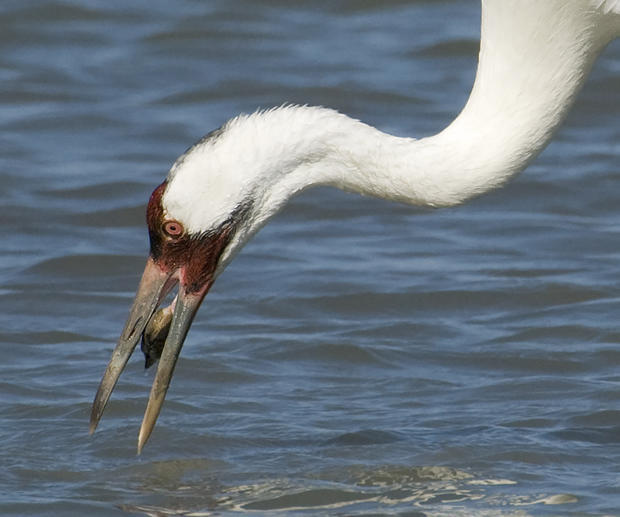Nature up close: Whooping cranes are finally making a comeback
By "Sunday Morning" contributing videographer Judy Lehmberg.
In the summer of 1998, while driving along the Slough Creek Road in Yellowstone National Park, my husband and I spotted two whooping cranes. Wait! Whooping cranes don't live in Yellowstone; they spend their winters in Aransas National Wildlife Refuge in Texas, and their summers in Wood Buffalo National Park in Canada, over 2,000 miles north of Yellowstone. Once we established that they were indeed whooping cranes, we enjoyed watching bird watchers scratching their heads as they combed through their bird guides wondering what could a very tall, mostly-white bird be, besides a whooping crane?
Remember the movie "Fly Away Home," in which a little girl trains a family of Canada geese to migrate by following her ultralight plane? The movie is inspired by the work of two men, Bill Lishman and William Sladen, who successfully trained Canada geese to migrate following an ultralight. In the 1980s researchers first trained sandhill cranes to follow an ultralight, and then whooping cranes. Dubbed Operation Migration, it had mixed success. The cranes repeatedly got too close to humans, so they were moved to a more remote area of Yellowstone. In the end, it failed. But biologists, thankfully, did not give up.
The stately, majestic whooping crane has never been a common bird in North America. Their population is estimated to have been between 10,000 to 20,000 birds before European settlers arrived in the New World. By the 1870s their population was down to around 1,350 birds. In 1938 that number was 15 in one single migratory flock that wintered along the Texas coast (in what is now Aransas National Wildlife Refuge), and bred in some unknown location in Canada. There were also 15 in a non-migratory flock in Louisiana, but a 1940 hurricane killed half of them and scattered the rest.
Their decline was due to over-hunting, low reproductive rates, and, primarily, loss of habitat. As more and more of the American prairie (and most importantly the pot holes left behind by the last glaciers) were tilled for farming, the birds continued to lose habitat essential for their migration refueling stops. Their low reproductive rates are due to a combination of being slow to reach sexual maturity and laying two eggs, only one of which normally survives.
One of the Louisiana survivors, a female, was taken into custody at the Audubon Zoo in New Orleans, and was later joined by two injured males from the migratory population. Josephine, as the female became known, lived another 25 years but only produced four chicks that survived to maturity. During that same time the wild migratory population increased by only ten birds. Things were looking dire for the species.
Luckily, after much searching, the migratory population's breeding grounds were accidently found in Canada's Wood Buffalo National Park in 1954. Whooping crane conservationists finally had a source of fertile whooping crane eggs. They could remove one from a nesting pair without any adverse effects on the wild population.
In the intervening years much had been learned about how to get captive whooping cranes to successfully reproduce. In 1976 the wild population only had 60 birds and had only increased their population by 10. Ornithologist George Archibald, who was the co-founder of the International Crane Foundation, began training a female whooping crane, Tex, to come into breeding condition. It took him three years to succeed, during which time he walked, danced and called like a whooping crane to get her ready for mating. He pioneered much of the methods still used to encourage mating in captive birds as well as rearing their chicks with the use of hand puppets that look like whooping cranes. She, most unfortunately, died after successfully hatching her first chick.
By that time Patuxent Wildlife Research Center, in Laurel, Md., had also "cracked the code" on whooping crane captive breeding. In just under 40 years, one of their male cranes sired, grandsired or great-grandsired 186 captive bred chicks. Unfortunately, the Patuxent center closed after 51 years of breeding and training whooping cranes for release into the wild following budget cuts by the Trump Administration in 2017. Because the Patuxent birds could not all be moved to the same location, its closure has had extremely negative effects on the captive breeding program.
Over the years several reintroduction programs have been attempted with varying success. In the 1970s eggs taken from whooping crane nests were placed in sandhill crane nests at Gray's Lake National Wildlife Refuge in Idaho. It seemed to work. The sandhill cranes accepted the whooping crane eggs, raised the chicks and taught them to migrate to Bosque del Apache National Wildlife Refuge in New Mexico. After a few years however, it became obvious the plan was flawed. There were only a few whooping cranes – and thousands of sandhills. When the whooping cranes matured, they picked sandhills for their mates, producing hybrid offspring, so the program was discontinued.
That's when the ultralight planes flown through Operation Migration came into use. Some migratory birds know where to go without being taught by their parents, but not whooping cranes. Their parents teach them the route. Fifty years ago there was only one wild migrating population, the Aransas-Wood Buffalo group (which is also the largest population). For years biologists worried it would only take a late-season hurricane or an oil spill to crash the Aransas wintering cranes.
In August 2017, Hurricane Harvey hit Aransas National Wildlife Refuge not once, but twice, wiping out 20 feet of coastline, killing 300+-year-old oak trees, and forcing saltwater into what had been prime freshwater whooping crane habitat. (And dumping 53 inches of rain on our house.) But nature is resilient, and the cranes came down that year and appeared to do okay.
In the last few years a longtime goal of whooping crane biologists has finally been realized by the establishment of a second migratory flock that moves between Florida and Wisconsin. After several tries, and failures, a non-migratory population is now holding its own in Louisiana as well. Those two groups, along with the original Aransas-Wood Buffalo population and captive whoopers, brings their total population to just over 800. After almost 80 years, thousands and thousands of man hours and untold millions of dollars, we have 800 whooping cranes. It is difficult to say that is a total success, but it is impossible to imagine a world without whooping cranes.
One of the first courses I took in graduate school was "Evolution." Our professor, mostly to try to start a discussion, said whooping cranes were functionally extinct. He meant that not only were their numbers very low (around 60 at the time), but their gene pool was very small. It is still small today. There is not complete consensus as to how many individuals constitute a viable population of vertebrates, but 5,000 is probably the most commonly-agreed-on number, although some argue at least 7,000 are necessary to ensure long-term survival. At a little over 800 individuals, whooping cranes haven't fully recovered, but I find it very satisfying to know that during my lifetime they have gone from literally the brink of extinction to, if not a super-healthy population, at least one that is far from the danger of extinction and will most likely have 1,000 birds within the next few years. With new habitat added around Aransas National Wildlife Refuge, and finally an established second migratory population, the chances of their survival continue to improve.
Your best chances of seeing whooping cranes are from several commercial boats that go out from Rockport, Texas to the bay side of Aransas National Wildlife Refuge. A couple of choices are: Rockport Adventures, which specializes in whooping crane tours; they are relatively inexpensive and take out over 40 people at a time. If you are a photographer or would just like a small group size, Aransas Bay Adventures may be more to your liking. We've done both, the former when we took out large student groups, and the latter when we wanted to photograph whooping cranes.
Judy Lehmberg is a former college biology teacher who now shoots nature videos.
See also:
To watch extended "Sunday Morning" Nature videos click here!





